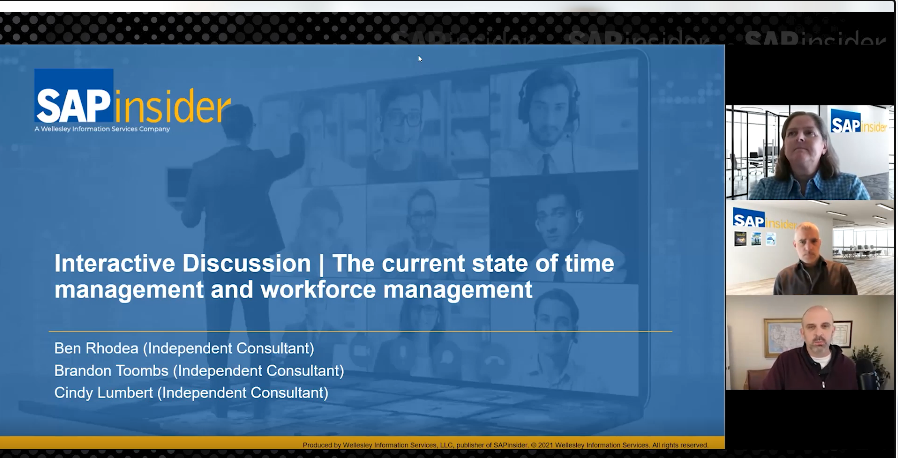Time and Attendance: The Foundation of an HXM Digital Transformation Strategy
Meet the Authors
Key Takeaways
⇨ When considering their HCM/HXM strategies, organizations should first look at time and attendance functionalities.
⇨ Time and attendance solutions have a proven track record of delivering elevated ROI.
⇨ These solutions cater to the needs of deskless workers, helping ensure all members of an organization are compliant and accounted for in a holistic view of a workforce.
In 2019, SAP redefined its HCM solutions as HXM solutions – human experience management. This shift emphasized the importance of how workers feel about their tasks, social experience, and fulfillment. People want to work at an organization where they can easily accomplish tasks, like their coworkers, and provide personal and career fulfillment. Years later, organizations are still doing their best to meet these criteria.
As digital transformation continues to be a key topic for SAP organizations, businesses must ensure that they are transforming their HCM practices as well. It is vital that organizations adapt as the needs and wants of employees evolve. Organizations that keep pace will be better able to attract top talent and maintain a competitive advantage.
Time and Attendance
Explore related questions
When considering their HCM/HXM strategies, organizations should first look at time and attendance functionalities. Time and attendance management solutions have a strong track record of delivering positive ROI for users, while boosting engagement, productivity, and business performance, according to the SAPinsider HCM and SAP S/4HANA Benchmark Report.
Organizations that feel as though they are ahead of the market in terms of HCM technology, known here as “leaders,” tend to rely on time and attendance solutions – 83% of this group leverages time and attendance applications. Those organizations that feel that they are behind their competitors, known here as “laggards,” are much less likely to use time and attendance solutions, at just 42%.
One of the top strategies organizations use for this purpose is SAP Time and Attendance Management by WorkForce Software. The solution extension enhances native SAP applications and has a proven track record of promoting employee engagement.
This solution helps address one of the most overlooked yet significant challenges in the HCM space – deskless workers. Nearly 80% of the global workforce is considered “deskless,” as they do not have a specific workspace or office that they go to each day.
Without sitting at a computer, organizations often have no way to manage their deskless workers. Yet the time and attendance solution offers companies the ability to gain a comprehensive view of desked and deskless workers alike, which not only helps with compliance, but provides a holistic view of an organization’s entire workforce. This view helps boost engagement and productivity by offering business leaders the data they need to make more informed decisions.
Adopting time and attendance solutions can also ensure that organizations remain compliant. With evolving regulations around flexible scheduling requirements, it is important for companies to be able to ensure they have the agility to meet these requirements within the system that they already have in place.
Cloud Adoption
SAP organizations are faced with a multitude of choices when adopting new solutions – chief among these is the decision of whether to leverage the cloud, stay on-premise, or use a hybrid approach. Leading organizations have a clear preference for the cloud, as those who consider themselves leaders are 50% more likely to run SAP HXM SuccessFactors in the cloud compared to their laggard counterparts.
Cloud-based HXM solutions offer advanced HR technologies such as HR analytics, intelligent automation (including AI and RPA), and cloud-based development and extension platforms like SAP BTP.
The SAPinsider HCM and SAP S/4HANA Benchmark Report found that organizations that leverage cloud technology rather than on-premise are “more likely to reap the benefits of HXM adoption, such as greater efficiency, improved employee satisfaction, and enhanced employee communication, representing the top business outcomes identified by leading organizations.”
Roadmap
There are many facets of the HXM strategy that differ from the past HCM methods. One of the key components is a strategic roadmap. Employees want to feel that they are progressing in their careers, as well as contributing to the overall success of the organization. Laying out a career roadmap that is aligned with business objectives and the evolving needs of an employee offers workers a more connected experience.
Businesses can also use roadmaps to help develop a more performance-driven culture within the organization. Many companies lay out goals and track employee performance as a way to improve the employee experience. Some even calculate compensation based on performance, which has proven to improve engagement and productivity.
What this means for SAPinsiders
In 2023, companies are still adapting to the shift to HXM from HCM. Over the past few years, leading organizations have learned that it is important to have a holistic approach to meeting their HXM goals. The greatest defining factor between leaders and laggards has proven to be a robust time and attendance strategy, like the one provided by Workforce Software.
Time and attendance solutions have a proven track record of delivering elevated ROI for organizations that use them, compared to other similar organizations who lack these solutions. As the needs of workers evolve, time and attendance solutions also ensure that organizations are compliant with flexible scheduling requirements. They can also help cater to the needs of deskless workers, helping ensure all members of an organization are compliant and accounted for in a holistic view of a workforce. This helps give decision-makers a complete understanding of all workers, empowering them to develop a more inclusive culture, foster productivity, and enhance engagement.






